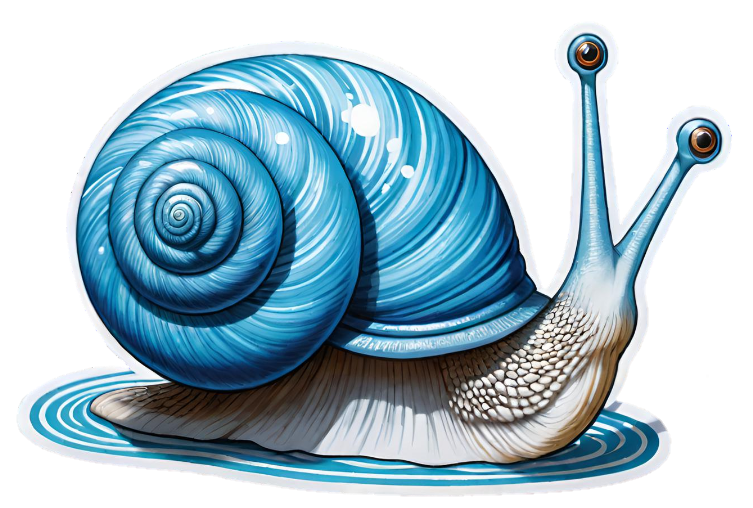Shab'lul Snail
Persistant to an extreme, Shab'lul Snails reside in the most unlikely of habitats--the radiant sands of the Shamsi Desert! Snails need moisture in order to survive and these air-breathing desert-dwellers are no different. In fact, most of their body weight comes from the water in their body. In order to evade dessication, destruction from dehydreation, Shab'lul are only active for a small period each year, somewhere between 18-26 days! The rest of the year they aestivate (hibernating in summer) either beneath the sand or under rocks. They only become active during the wet season when winter rains flood the desert, usually between November and March. Hoards of Shab'lul gather in this window, rapidly eating, mating and laying eggs before aestivating again. Throughout the rest of the year, their small, stark-white shells cluster together under large stones or deep within the sand, a welcome snack to the industrious scavengers of Shamsi.
|
Ithisda's Sense
Those with Ithisda's Sense are able to feel water in their environment and feel anything interacting with it despite any barriers and over considerable distances. Most often, this species uses this ability to perceive oases or flooding amid the wet season, vital to their survival in the desert and to find wet habitats.
Vekaltor's Sense
Those snails with Vekaltor's Sense are able to sense the weather in their environment and feel anything interacting with these phenomena despite barriers and over long distances. Often, they can sense incoming rain amid the wet season, rousing from hibernation before the inundation begins.
Rithaldis' Manipulation
With Rithaldis' Manipulation, Shab'lul are able to manipulate and reshape solar energy present in their environment. This species naturally repels this radiant energy which includes strong sunlight, solar plasma and radiation. Even their shells, when crushed into a powder, repels radiation
|
Anatomy |
Original Ancestor | Lifespan |
|---|---|
Sphincterochila zonata zonata Desert Snail | 8 years |
Diameter | Weight |
25 mm .98 in | 4.3 g .15 oz |
Coloration |
|---|
Generally, these snails have a stark white shell and an azure blue body but these colors may still be present on any part of their body, blending together. Sometimes, their shell may even give off a faint light! |
Adaptions |
Like many snails, Shab'lul are deaf and their eyes only perceive light and shadow! But this isn't to say they have poor senses, relying instead on their sense of touch and smell. In fact, their sense of touch is heightened enough that they can taste what they touch! The tentacles on their head are especially sensitive, reacting quickly to anything they touch. Shab'lul are able to retract both these tentacles and their entire body reapidly when touched, a strong muscular reaction. They navigate the world through this sense of touch but especially via their strong sense of smell. This is how they seek out food in their environment and to retreat back to their shelter. While their eyes only perceive light and shadow, these are still useful for determining the time of day and perceiving shadows overhead, typically predators. And while they have no auditory organs, completely deaf, they can still sense virbations with their body which is mostly water. Shab'lul spend much of their life hidden away in cracsk and crevices or beneath desert sands. When there is no cover available, Shab'lul will burrow under the sand or soil at a dept of 3-16 in (1-5 cm). In this state, a thick ephiphragm sealing the opening of their shell. They can easily withstand temperatures up to 122 F (50 C) wheras anything over 131 F (55 C) is lethal. They lose around .5 mg of water a day and have little need for oxygen. Their shell is exceptional at reflecting sunlight and in fact any light on the electromagnetic spectrum, around 90% of light! Together, these features not only repel heat and strong sunlight but seal as much moisture inside their shell as possible--one of many features which allow them to reside where few other species can. Incredibly, Shab'lul can withstand drought for several years, even those removed from their natural environment able to survive in dormancy for up to 6 years! This means fewer predators or competition and they may even find their way into new habitats carried in the hooves and paws of animals or washed away via flooding. |
Habitat |
Shab'lul only live in the Shamsi Desert, Birit Narim, Kemet, and Kna'an, preferring desert habitats where loess or limestone soils are prevalent. They hide within barren regions of the desert where other lifeforms are sparse. When the soil is dry, they remain dormant and do not emerge until they sense water or rain. They are perhaps most numerous in wadis, in dryed up riverbeds which flood once more during the rainy season! |
Diet |
[Shab'lul are mostly decomposers but will also feed on small plants such as lichens, mosses and algae. Their favorite food is actually soil, especially moist mud containing limestone or loess. They are a sought out meal for residents of Shamsi, rodents like the Qafz Jerboa scouring desert scrub for them alongside seeds and insects. Because their shells repel radiation, they are a safe food for any desert species which may not have immunity to radiant energy. In fact, there are even humans which may scavenge for Shab'lul as they hibernate, considered a special delicacy. Otherwise, their shells can be ground up into a powder which repels and cleanses radiation, useful for both Material Magic and True Magic! |









Comments